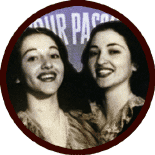The Rise of Yiddish Swing
Yiddish swing. Jazz and klezmer. It may sound like an odd combination, but
in late 1937 this mix of Old World and New took the music scene here and abroad
by storm. The fad got its start when the Andrews Sisters, a young three-sibling
act fresh from Minnesota, recorded an irresistible swing version of a forgotten
Yiddish stage tune. "Bei Mir Bist du Schoen" (You Are Beautiful to
Me) became an instantaneous hit, spawning an unending series of covers
and, with them, a musical trend.
Within weeks, executives at New York's WHN had created Yiddish Melodies
in Swing, a weekly program dedicated to the new musical fusion. The talented
pianist/composer Sam Medoff was hired to lead the show's “Swingtet”
and to arrange rollicking versions of traditional Jewish folk and klezmer tunes
like "Dayenu," "Eli Meylakh," and "Yidl Mitn Fidl."
Front and center on Medoff's bandstand were the Barry Sisters (née Bagelman),
whose close-as-air harmonies, spunky energy, and seamless transitions from Yiddish
to English packed New York's 600-seat Loews State Theater every Sunday
at 1 p.m. But Yiddish Melodies didn't just mainstream Yiddish
culture, it reconnected a younger generation of American Jews to an older musical
tradition embodied by the Swingtet's legendary clarinetist, Dave Tarras, a European-born
klezmer musician with almost no equal.
Yiddish Melodies in Swing lasted nearly two decades, outliving swing,
the golden age of radio, and almost Yiddish culture itself. Small wonder that
the 26 surviving episodes of the show are as fresh today as they were on the
Sunday afternoons when they aired.


